
Explore Make it Big 2022 On Demand
Level up your ecommerce knowledge with future-focused content from our virtual Make it Big conference.

10 Ways to Dress Up Your Fashion Ecommerce Strategy
Haylee Reed
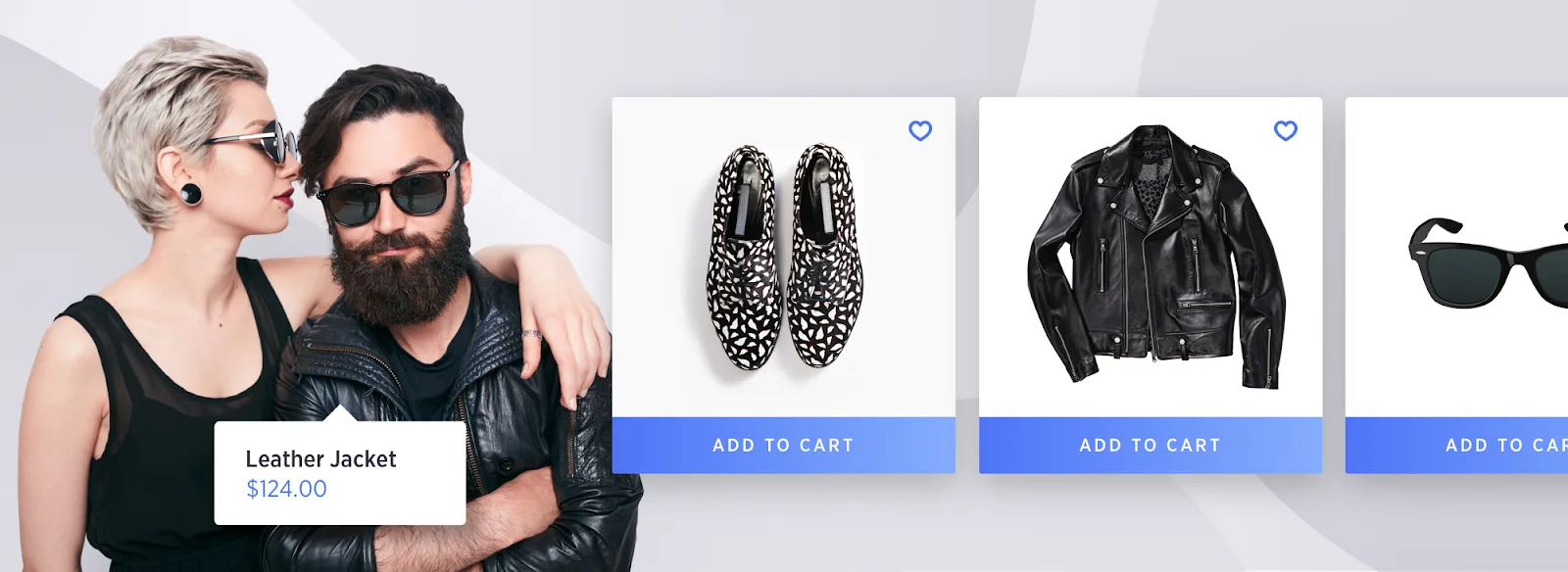
“By 2022, brick-and-mortar retail spaces will be little more than showrooms,” wrote BigCommerce co-founders Eddie Machaalani and Mitchell Harper — and that was back in 2013.
Today, their prediction still rings true. Physical stores are no longer the only way that shoppers are interacting with brands, especially fashion retailers. As shoppers increasingly expect mobile purchasing, one-day shipping and 24/7 customer support, fashion retailers are redesigning the entire shopping experience.
Luckily, the fashion industry is already a master of change, with seasonal trends coming and going before you can even take a breath. However, the fashion world’s digital transformation may be its greatest change yet.
From larger luxury brands to smaller names like Modern Vintage Boutique, retailers across the industry are tailoring their ecommerce strategies to attract customers and adapt to the evolving landscape.
Fashion Ecommerce Trends and Statistics
When styling your own fashion ecommerce strategy, it’s key to understand the current state of the ecommerce fashion industry as well as where it’s heading.
Looking to 2022 and beyond, we’ve highlighted some of the key trends and statistics shaping the online fashion industry and how they may help strengthen your ecommerce business strategy.
From ecommerce integrations to omnichannel selling, these trends are paving the way for a new approach to online fashion.
1. Fashion ecommerce continues to grow.
The past few years have undoubtedly accelerated the fashion industry’s digital transformation.
According to Statista, in 2020, fashion ecommerce sales accounted for nearly 30% of the total fashion retail sales in the United States and have steadily climbed in annual growth rate since 2003. And in 2021, apparel and accessories will be the only product category to outpace its 2020 online growth, up 23.1%.
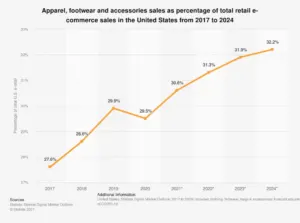
But the future looks even brighter for fashion ecommerce. Looking ahead, online sales will account for 24% of total fashion market revenue by 2023, up from 22% in 2021.
With drivers of growth such as digital channels, increased online access through mobile devices and technological innovations, it’s no wonder that the online fashion market has skyrocketed.
With this trajectory in mind, ecommerce brands have the opportunity to maximize their growth and take advantage of revenue potential.
2. Fashion is adapting to the COVID world.
The COVID-19 pandemic has not only presented a global health crisis but also a harsh blow to the fashion industry. In Europe’s apparel sector, clothing production decreased by 37% during the peak of the pandemic in 2020, and clothing sales fell 43% compared to sales in 2019. This shock echoed across the industry, leaving many merchants unsure of how to respond to shifting consumer behaviors.
However, while many apparel brands did take a hit during the pandemic, some online retailers are fending better than others — particularly those who have leveraged their ecommerce sites and strengthened their digital strategies. In fact, 47% of fashion retailers have not adjusted their e-commerce strategy since the beginning of the pandemic.
According to McKinsey & Company, major ecommerce brands like ASOS, Revolve and Zalando have thrived even during the pandemic, and by August of 2020, “digital-first players were trading 35% higher, on average, than they did in December 2019.”
Especially as many storefronts remain shuttered, the pandemic is increasingly widening the gap between digitally mature retailers and those who lag behind.

However, while digital leaders in the fashion space may have an advantage now, there is the potential to fall behind if other competitors up their digital capabilities. On the other hand, retailers who are just starting out on their digital journey still have the opportunity to gain market share by investing in their digital strategies.
These digital capabilities not only provide additional sales channels, but also allow for a cheaper, more efficient value chain. With improved options for logistics and sales fulfillment, as well as customer acquisition and inventory management, digitization is a powerful tool for improving processes.
By upping their digital capabilities and investing in their ecommerce strategies, fashion retailers have the opportunity to not only survive the pandemic, but perhaps even thrive in it.
3. Sustainability and ethical sourcing are key.
The fashion ecommerce industry has also seen an increase in shopper advocacy for social justice and environmental resilience.
While green consumerism was already on the rise before the pandemic, the past year has only amplified the movement toward sustainable practices. The fast fashion industry held a market value of $36 billion in 2019 and will have a projected $43 billion in 2029.
Unfortunately, the fast fashion industry comes with a price tag of environmental effects, including an excessive use of water, the release of harmful chemicals and greenhouse gas emissions. Moreover, the industry has been under scrutiny for social injustice in the supply chain, as reports emerge about underpaid garment workers and unsafe working conditions.
As a result, fashion retailers face increasing pressure to not only produce quickly to remain competitive, but to do so with respect for both their workers and the environment. The pandemic has amplified awareness surrounding environmental and social governance issues, and more and more consumers — and investors — are seeking transparency.
With 57% of UK and German consumers making “significant changes to their lifestyles” to mitigate their environmental impact, it’s no surprise that consumers expect the same from their favorite fashion brands.
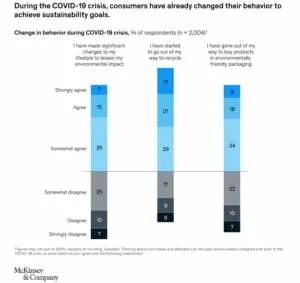
Thus, thrift and secondhand merchandising has become increasingly mainstream. By renting, reselling and reusing apparel, consumers are able to shop both economically and sustainably, rather than purchasing brand new items.
This drive for sustainability can even be seen in higher end fashion brands. In fact the CFDA (Council of Fashion Designers of America), which organizes New York Fashion Week, partnered with Boston Consulting Group to produce “Sustainability by Design: Rethinking New York Fashion Week,” a study focusing on environmental issues such as pollution and climate change within the fashion industry.
4. Seasonless and genderless promotes longevity.
This growing trend toward sustainability now begs the question, “Do we really need new clothes for every season?” Contrary to the traditional fashion machine, which churns out new clothing lines every season and new collections for international fashion weeks, many fashion brands are taking a step back and simply doing less.
French brand Louis Vuitton has chosen to go seasonless for New York Fashion Week, and Michael Kors even revamped its traditional fashion calendar, reducing its production to only two collections per year.
With such big-name brands leading the way, more and more fashion retailers are focusing on longevity rather than newness. As a result, shoppers are able to save money, protect the environment and love their clothing longer.
But seasonless isn’t the only category making moves in the fashion world. In an additional effort to produce less, many players in the industry are also embracing genderless fashion.
A huge step for the LGBTQ+ community, the introduction of unisex/nonbinary clothing lines has opened the door to greater inclusivity and diversity withinin the fashion industry. Considering 41% of Gen Zers identify as neutral on the gender spectrum, it makes sense that 56% are also shopping outside of their gender — otherwise known as “cross-buying.”
In response, many fashion brands are launching genderless collections and casting models all across the gender spectrum in hopes of breaking the barrier between masculine and feminine fashion.
5. Athleisure continues to be a growing segment.
With many consumers still working from home and staying indoors, it’s no wonder that athleisure has become one of the fastest growing sectors of the fashion market. Valued at roughly $354 million in 2020, the size of the activewear market is projected to climb by 25 percent by 2026, with women’s activewear being one of the leading segments.
With this significant growth in mind, it’s no surprise that activewear brand Lululemon saw a 130% increase in online searches in 2019, and retailers Amazon and Target are now sporting their own athleisure collections.
As the name suggests, consumers are drawn to athleisure goods for both athletic and comfort purposes. Especially as gyms and fitness studios closed during the pandemic, many individuals embraced home and outdoor workouts, spurring a demand for activewear products.
Nonetheless, a 2019 RBC Capital Markets’ United States survey found that only 30% of respondents purchased athleisure goods for athletic purposes. With “work-from-home” becoming a style of its own, many shoppers are seeking athleisure products for their comfort, ease and even luxury.
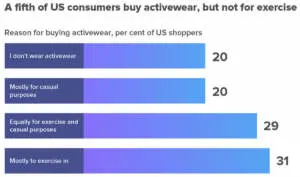
6. AR and VR create virtual fitting room experiences.
With the shift toward digital shopping experiences comes the challenge of ensuring that shoppers are completely satisfied with their purchases. Luckily, numerous smart-fitting technologies are aiding the fashion market in catering to the needs and wants of its customers.
Some smart-fitting technologies allow customers to find their perfect size by providing their specific measurements, answering a few simple questions or inputting their typical sizes for other brands. The platform then compares product sizes to items that the customer already owns and loves, and using data technology, gives the customer size and style recommendations.
Other technologies go beyond this functionality, using 3D technology and augmented reality to show exactly what a product would look like on the customer or a model. By detecting the customer’s contour and letting them choose which clothing items they want to try on, AR and VR fitting rooms provide a clear picture of the size, fit and style of a product — all from the customer’s mobile device.
Of course, purchasing any item online (especially one that’s high-cost) may seem risky enough, but purchasing a clothing item without physically trying it on adds a new level of uncertainty. However, augmented and virtual fitting rooms are working to ease the anxiety and provide shoppers with an experience that matches that of a brick-and-mortar store.
7. Give personalized recommendations using AI.
Two of the primary reasons for ecommerce are its ease of use and convenience. But now, more fashion ecommerce sites are also harnessing its ability to customize experiences and give shoppers what they want in the shortest amount of time. As 43% of purchases are made as a result of personalized recommendations, it’s evident that shoppers are actively seeking online experiences that mimic — or even exceed — those in-store.
Using artificial intelligence and tracking consumer behavior, ecommerce retailers can provide personalized product recommendations based on a customer’s previous purchases, browsing history and situational targeting.
Perhaps a shopper clicks on a sweater and scrolls down to find a “You May Also Like” or “Customers Also Viewed” section. Or, perhaps they previously browsed through the men’s section on your website, and the next time they return, the homepage features product recommendations for men’s apparel.
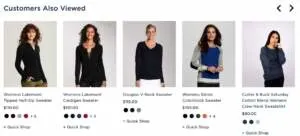
This AI functionality can even go a step further by offering “virtual style assistants.” While some of these assistants may be real people working behind the scenes to customize shoppers’ closets, many are actually automated chatbots.
Mode.ai — a startup that creates chatbots for ecommerce retailers — helped build Levi’s Virtual Stylist, which assists shoppers in finding their perfect pair of jeans based on fit, rise and stretch preferences. Additionally, the chatbot feature compares product sizes to the customer’s other favorite brands to provide an accurate size and style recommendation.
8. More brands are taking an omnichannel selling approach.
Whether they’re staying at home, eager to shop in-store or a mix of both, customers crave a holistic, engaging experience across all channels, both online and offline.
You may already be familiar with the term “multichannel commerce,” which is a retail strategy for a brand that exists across multiple channels, whether they be a brick-and-mortar store, social media page, online website or apps. However, these channels may or may not hold a consistent customer experience across all consumer touchpoints. Thus, omnichannel commerce takes the multichannel strategy to the next level by connecting all channels to create a seamless customer experience, which could result in a 33% increase in revenue.
Especially post-pandemic, brands can no longer rely solely on face-to-face interactions with customers. With consumers spending more time online during the pandemic and less time in-store, fashion retailers must learn how to engage customers across a variety of channels.
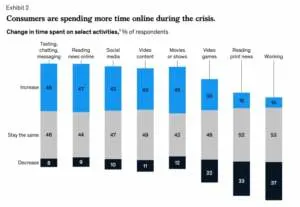
One significant way that ecommerce fashion brands are embracing omnichannel is through social commerce. Particularly within the past year, tools such as Instagram Shoppable Posts, Instagram Checkout, Facebook Shop, Pinterest for Business and marketplaces like Amazon, eBay and Google have given fashion retailers the ability to reach customers across a variety of platforms.
Of course, with an abundance of channels comes the potential for customers to become overwhelmed by their options. As a result, many shoppers prefer to consult a variety of channels and compare products before making a final purchasing decision.
Since many online shoppers go to search engines first before making a purchase, it’s key for online fashion retailers to implement strong SEO practices that will improve their website’s ranking and visibility.
9. Customers love buy now, pay later options.
Due to recent supply chain and inventory issues, as well as holiday-related sales starting earlier in the season, shoppers are more inclined to shop ahead of time. For early-bird shoppers, layaway plans used to be the only option, allowing customers to reserve items and make payments over time. However, fintech startups such as Sezzle, Afterpay, Klarna and Affirm are paving the way for a new type of payment plan: buy now, pay later (BNPL).
BNPL is a deferred payment method that allows shoppers to purchase items with little to no up-front payment and instead pay the remaining balance in a few installments. Compared to layaway plans, BNPL plans charge little to no interest and pose little threat to the shopper’s credit score.
Not only are these short-term loans easier for fashion retailers to manage, but they also allow for a more seamless online transaction and user experience. In fact, RBC Capital Markets found that offering a BNPL plan increases retail conversion rates 20% to 30%.
10. Maintain great customer service.
Perhaps it goes without saying that customer service is, and always will be, key to success. But attracting and retaining loyal customers requires consistency and hard work, especially in the ecommerce playing field. With an abundance of online fashion sites to choose from, shoppers can easily switch from one retailer to the next if they aren’t receiving the value they expect.
So, how can you consistently provide quality customer service?
First, it’s important to always be available. As difficult as it is to work around the clock, customers on various time zones and schedules still expect support outside normal working hours.
But if hiring customer service reps isn’t an option, customer support automation may be the way to go. Artificial intelligence technologies such as chatbots, interactive voice response and self-service help centers are all effective tools to maintain consistent customer service.
Quality customer service is also about creating connections and improving relationships with your shoppers, and a great way to do this is through email marketing. As one of the most affordable yet effective channels for communicating with customers, email marketing allows retailers to resolve customer pain points, collect valuable feedback, notify shoppers about deals and new products and engage customers through personalized content.
Fashion Ecommerce Sites to Watch
With these trends in mind, let’s take a look at some exceptional fashion brands who are making strides in the ecommerce space. In a highly competitive industry, these fashion ecommerce stores stand out from the crowd by implementing current trends and continually strengthening their digital capabilities. Take notes and learn how you can do the same.
1. See Kai Run.
See Kai Run, a footwear brand for first walkers and children, launched its 422 collection in hopes of “taking steps to identify actions [they] can take to reduce [their] environmental impact.”
The eco-friendly shoe collection uses a majority of recycled, environmentally friendly materials such as recycled canvas uppers and eco-friendly elastic laces. Plus, the See Kai Run factories are certified as Higg Compliant for Responsible Sourcing and have recently been upgraded to “Better Business” status.
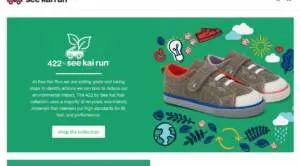
Whether it’s using eco-friendly materials, donating to social causes, practicing inclusive marketing or organizing supplier diversity programs, customers seek out brands that are driven by a greater purpose.
2. Réalisation Par.
Fashion brand Réalisation Par, founded by Alexandra Spencer and Teale Talbot, gears its online store toward social media platforms. Its Instagram profile features mainstream and micro-influencer marketing, compelling visuals, shoppable posts as well as curated Spotify playlists that help bring the brand to life.
Réalisation Par also expands its reach to Facebook, which lets customers browse products and easily migrate to the website to make purchases.

The seamless flow from channel to channel allows customers to find what they’re looking for — wherever they are — and enjoy an integrated, seamless experience.
3. Natori.
A New York-based apparel, lingerie and jewelry brand, Natori offers an online experience that feels luxurious and sophisticated. With beautiful photography, multiple product views and detailed product descriptions, shoppers can browse Natori’s full collection with ease.
But the designer brand’s success doesn’t just stop at its ecommerce website. Natori’s digital capabilities also extend to its social media channels.

Using an artificial intelligence marketing platform called Albert, Natori is able to generate direct responses to customers on social media and determine the most relevant and engaging content for its customers. Over time, as Albert collects more data, the platform becomes increasingly intelligent and continues to refine Natori’s content, resulting in increased conversions, revenue and ROI.
4. Jildor Shoes.
Starting as a single, family-owned brick-and-mortar shoe store, Jildor Shoes has expanded to four New York locations and stepped into the ecommerce space in 1999. With over 72 years of service, Jildor Shoes strives to provide customers with “service, selection and reliability.”
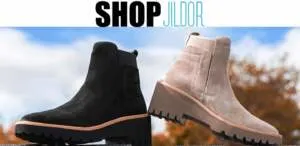
Jildor’s online store displays hundreds of product options, organizing them into product pages for “Just Arrived,” “Women’s,” “Bags,” “Trends,” “Designers” and “Sale,” making it easy for shoppers to sift through the large collection. Many products contain custom fields for sizes, color and widths, as well as customer reviews to help boost shopper confidence.
Designing a Memorable Online Shopping Experience
With fashion ecommerce brands of all niches and sizes competing for a place in the spotlight, it can be overwhelming to uncover just what it is that makes the best brands shine. It isn’t just the luxury brands or the big-name brands that succeed, but the ones that invest in ecommerce strategies to engage their customers and create a compelling user experience.
Here we’ve highlighted a handful of tactics that the best ecommerce brands have in common:
1. Personalized shopping experiences.
It’s one thing to offer a great deal, but it’s even better if that deal is catered specifically to your customer. Utilizing AI technologies and tracking consumer behavior are incredible tools for creating a customer experience that is unique, personal and consistent.
Nowadays, personalization isn’t a rarity, but a norm. And customers don’t just want personalized experiences — they expect them, whether that be including the customer’s name in mass emails or tailoring the homepage of your ecommerce website according to their previous search history.
2. High-quality product photography.
Have you ever ordered a piece of clothing online, but when it was finally delivered, the product just didn’t look like the image online? Nothing is worse than having an amazing product but not being able to accurately convey it online.
Luckily, top-notch product photography is a huge help. The best fashion ecommerce sites make sure to include high-quality visuals, such as 360-degree images of each product, multiple angle views, accurate depictions of each color option and options to zoom in on the intricacies of a product’s fabric and pattern.
A recent game-changer has been the inclusion of different size models on fashion apparel sites, which feature images of models of various heights, shapes and weights. Rather than displaying a photo of a dress on a model in only one size, some fashion retailers are going above and beyond by photographing a variety of sizes for the same article of clothing.
3. Leverage user-generated content.
What’s better than content you don’t have to create yourself? And better yet, it’s free?
A great way to get feedback on products and boost shopper confidence is through user-generated content. This may be customer reviews on your website, shared customer stories on Instagram or Facebook and photos tagged with your brand’s hashtag.
Considering 72% of consumers get their news from friends and family, it’s no wonder that word-of-mouth marketing is one of the most effective ways to attract and engage shoppers.
4. An enjoyable shopping experience.
Not only do customers desire a shopping experience that is quick and efficient — many of them also want it to be enjoyable! Through friendly designs that show off your brand’s flair and descriptions that give character to your products, you can create a customer experience that’s both effective and entertaining.
Make it easy for shoppers to find their perfect size and fit by implementing smart-fitting technologies or by featuring product reviews, which can help build trust and transparency with your customers.
5. Highlight your brand and what makes you unique.
In a crowd of fashion ecommerce brands, it can be easy to blend in with the rest. But to attract new shoppers and retain old ones, you need to flaunt what makes your site special!
Try revamping your About page with an appealing story that creates a personal connection with your customers. Or, try selling a specific look or niche category, such as vintage, bohemian or activewear.
6. Invite customers to be part of their community.
Lastly, one of the best ways to create a memorable shopping experience is by inviting customers into your brand community. By creating a rewards or affiliate program or linking your social media platforms to your ecommerce homepage, you can engage with customers on a more personal level and continue to build brand awareness.
Of course, it’s important that you choose the right community platform for your business. It might be Instagram, Facebook, Pinterest or even LinkedIn, but whatever platform you choose, make sure that you first identify your audience, define your goals and create a consistent brand voice across all content.
Conclusion
Needless to say, fashion ecommerce is growing and changing at a staggering rate, and as technologies continue to advance, this rate will only accelerate. This is exciting news for the industry, as traditional fashion retailers are now able to expand their reach from brick-and-mortar shops to ecommerce sites that reach shoppers across the globe.
Of course, this new opportunity also comes with considerable challenges, considering the already saturated market and ever-evolving trends — which come and go so quickly, it can get dizzying to keep up.
However, by following the lead of these online fashion brands and creating an outstanding customer experience, your ecommerce site will be dressed for success.

Haylee is a Content Marketing Writer at BigCommerce, where she partners with the SEO team to craft narratives and blog content. She earned a B.A. in English Literature from the University of Texas at Austin and afterward spent a year abroad to pursue a Master's in International Management from Trinity College Dublin. When she’s not writing, you can usually find Haylee with her nose in a book, enjoying live music or scoping out the best local coffee shops.


